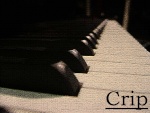Most confusing sheet ever? Need help ^_^
+2
CripKilla
VictorCS
6 posters
Page 1 of 1
 Most confusing sheet ever? Need help ^_^
Most confusing sheet ever? Need help ^_^
I've been reading a few sheets now, 2-3, and those have been easy to understand. I do believe that this piece is one of the more advanced I've started practicing, but the easier arrangment of the star wars theme just doesnt cut it. Anyway, I see this as a good opportunity to advance in sheet theory too.
1. There is no "circle of fifth" thing here, so I have kinda little problem with understanding what scale this is, but the piece ends on G.
2. Here the first chord shows three flats, but the second shows one, does that mean that the to others who where flat on the first changes to "normal"? And if it stays flat, why? ( there are some of the same thing all over this piece ).
3. Three chords, shall the last be play'd like the first, Aflat, C, Eflat? And why, since there is no flats on the last. And then we have that weird accidental, with a () surrounding it. EDIT: ( the accidental is a key that's not supposed to be in the scale... I forgot, so it's not an accidental, but the thing to cancel one )

1. There is no "circle of fifth" thing here, so I have kinda little problem with understanding what scale this is, but the piece ends on G.
2. Here the first chord shows three flats, but the second shows one, does that mean that the to others who where flat on the first changes to "normal"? And if it stays flat, why? ( there are some of the same thing all over this piece ).
3. Three chords, shall the last be play'd like the first, Aflat, C, Eflat? And why, since there is no flats on the last. And then we have that weird accidental, with a () surrounding it. EDIT: ( the accidental is a key that's not supposed to be in the scale... I forgot, so it's not an accidental, but the thing to cancel one )


VictorCS- Moderator

-
 Number of posts : 944
Number of posts : 944
Location : Norway
Length of time playing piano : Started playing seriously in 2007, and been doing so since.
Guru Points : 18
Registration date : 2008-03-09
 Re: Most confusing sheet ever? Need help ^_^
Re: Most confusing sheet ever? Need help ^_^
1. It is in C major(no sharps or flats)
2. The flat signs stay all the bar. It stop only if there is an accidental, which is not the case here.
3. yes, because sharps and flats last one bar.
2. The flat signs stay all the bar. It stop only if there is an accidental, which is not the case here.
3. yes, because sharps and flats last one bar.

CripKilla- Well-known Pianist

-
 Number of posts : 423
Number of posts : 423
Location : Hyrule Field
Job/hobbies : Bank Robber
Length of time playing piano : Since Huamn Existence
Guru Points : 12
Registration date : 2008-04-21
 Re: Most confusing sheet ever? Need help ^_^
Re: Most confusing sheet ever? Need help ^_^
Right now I wanna drive my head into the wall, I have the circle of fifth in front of me, has it all the time. And I didnt notice that C major doesnt have a key signature... ^_^
I'm gonna study music notation symbols tomorrow, to get wiser
I'm gonna study music notation symbols tomorrow, to get wiser

VictorCS- Moderator

-
 Number of posts : 944
Number of posts : 944
Location : Norway
Length of time playing piano : Started playing seriously in 2007, and been doing so since.
Guru Points : 18
Registration date : 2008-03-09
 Re: Most confusing sheet ever? Need help ^_^
Re: Most confusing sheet ever? Need help ^_^
CripKilla wrote:1. It is in C major(no sharps or flats)
2. The flat signs stay all the bar. It stop only if there is an accidental, which is not the case here.
3. yes, because sharps and flats last one bar.
Great
 Re: Most confusing sheet ever? Need help ^_^
Re: Most confusing sheet ever? Need help ^_^
Glad to help! 

CripKilla- Well-known Pianist

-
 Number of posts : 423
Number of posts : 423
Location : Hyrule Field
Job/hobbies : Bank Robber
Length of time playing piano : Since Huamn Existence
Guru Points : 12
Registration date : 2008-04-21
 Re: Most confusing sheet ever? Need help ^_^
Re: Most confusing sheet ever? Need help ^_^
It's not in C, it's in B flat major. They just didn't put the flats at the beginning. It's not the key armor that decides what tonality a piece is in, it's the cadences!
 Re: Most confusing sheet ever? Need help ^_^
Re: Most confusing sheet ever? Need help ^_^
huh???
I always thought "no sharps or flats in the key signature" is ALWAYS a C major?!?!?!?!
I always thought "no sharps or flats in the key signature" is ALWAYS a C major?!?!?!?!

aendym- Well-known Pianist

-
 Number of posts : 208
Number of posts : 208
Age : 43
Location : Germany
Job/hobbies : Teacher - other than that painting, drawing and being creative
Length of time playing piano : August 2009
Guru Points : 13
Registration date : 2009-07-26
 Re: Most confusing sheet ever? Need help ^_^
Re: Most confusing sheet ever? Need help ^_^
No, no sharps or flats can also mean A-minor. You determine the tonality by seeing where the cadences lead you to. Here, they only lead to B flat major, apparently.
 Re: Most confusing sheet ever? Need help ^_^
Re: Most confusing sheet ever? Need help ^_^
ok, now heres a really stupid question: how do I see where a cadence leads to??  (sorry, Im sure Andrew has already covered that topic in his videos... I just haven gotten that far yet! =)
(sorry, Im sure Andrew has already covered that topic in his videos... I just haven gotten that far yet! =)

aendym- Well-known Pianist

-
 Number of posts : 208
Number of posts : 208
Age : 43
Location : Germany
Job/hobbies : Teacher - other than that painting, drawing and being creative
Length of time playing piano : August 2009
Guru Points : 13
Registration date : 2009-07-26
 Re: Most confusing sheet ever? Need help ^_^
Re: Most confusing sheet ever? Need help ^_^
Well, in tonal music you have harmonic patterns known as cadences. Usually they use dissonance as an element of tension, and consonance as resolution. In English: a dominant chord (for example G7 in C major) resolves on the tonic (C major). The dominant is the 5th grade of the scale (G in C, E in A, F# in B etc.) So to identify the tonality you're in, you look for the first cadence: find a 5-1 chord progression.
Usually the 5 chord (dominant) has a dissonance (the 7th: for example G7 = G B D F, where F is the dissonance) and the 1 (tonic) has none. Because of this, you feel that a piece can't end on the dominant, it needs the tonic as a resolution because of the dissonnance.
In minor tonalities, cadences are very easy to find out, because the dominant usually needs an accidental to exist. (for example in A minor, the dominant is E7 = E, G#, D, E; you need a sharp sign on the G becayse the key signature has no sharps or flats.)
Usually the 5 chord (dominant) has a dissonance (the 7th: for example G7 = G B D F, where F is the dissonance) and the 1 (tonic) has none. Because of this, you feel that a piece can't end on the dominant, it needs the tonic as a resolution because of the dissonnance.
In minor tonalities, cadences are very easy to find out, because the dominant usually needs an accidental to exist. (for example in A minor, the dominant is E7 = E, G#, D, E; you need a sharp sign on the G becayse the key signature has no sharps or flats.)
 Re: Most confusing sheet ever? Need help ^_^
Re: Most confusing sheet ever? Need help ^_^
oh, hey thanks matthieu...
but come to think of it, it does sound a bit familiar, what you are saying... I might have already seen one of andrews videos on this topic. but it seemed so confusing, that I forgot it again... =)
Ill try to remember this time!
but come to think of it, it does sound a bit familiar, what you are saying... I might have already seen one of andrews videos on this topic. but it seemed so confusing, that I forgot it again... =)
Ill try to remember this time!

aendym- Well-known Pianist

-
 Number of posts : 208
Number of posts : 208
Age : 43
Location : Germany
Job/hobbies : Teacher - other than that painting, drawing and being creative
Length of time playing piano : August 2009
Guru Points : 13
Registration date : 2009-07-26
 Re: Most confusing sheet ever? Need help ^_^
Re: Most confusing sheet ever? Need help ^_^
I don't really know which topics Andrew covered as I have only watched few of his videos - I am a professional pianist... Maybe he explained this in a totally other way (there are many ways to explain harmony, even simple harmony  )
)
Anyway, this whole cadence thing is to be FELT on the piano, not only read on paper; it's important to learn pieces, improvise, compose etc. but you won't get satisfactory results from it if you don't sit down and listen to cadences, play them, and learn to feel what they mean, musically.
Anyway, this whole cadence thing is to be FELT on the piano, not only read on paper; it's important to learn pieces, improvise, compose etc. but you won't get satisfactory results from it if you don't sit down and listen to cadences, play them, and learn to feel what they mean, musically.
 Re: Most confusing sheet ever? Need help ^_^
Re: Most confusing sheet ever? Need help ^_^
Most awesome explanation ever.
Harmony is a tough subject, I feel as it's pretty much everything in there, but as a beginner I'm not even sure where to start to learn about it, there's lots of books I think but just reading theory is not enough...
Harmony is a tough subject, I feel as it's pretty much everything in there, but as a beginner I'm not even sure where to start to learn about it, there's lots of books I think but just reading theory is not enough...
endre- Well-known Pianist

-
 Number of posts : 113
Number of posts : 113
Age : 47
Location : Budapest
Job/hobbies : IT
Length of time playing piano : april 09
Guru Points : 1
Registration date : 2009-03-22
 Similar topics
Similar topics» confusing terble clef plus lower notes played together
» it's this sheet the same as the video?
» Need help n some music sheet questions
» Two instruments in the same sheet?
» sheet reading help plz !
» it's this sheet the same as the video?
» Need help n some music sheet questions
» Two instruments in the same sheet?
» sheet reading help plz !
Page 1 of 1
Permissions in this forum:
You cannot reply to topics in this forum
 How to play piano.ca
How to play piano.ca



» What's Happened...?
» Thomas's Performances - NEW Liszt Moments Musicaux D.01 - Page 39
» latin rhythms on piano
» What is the deal with time signatures with a bottom number of 16?
» Piano Dog's Lick of The Week
» How to span notes
» Great sight reading exercises
» Hey guys! How's it going?